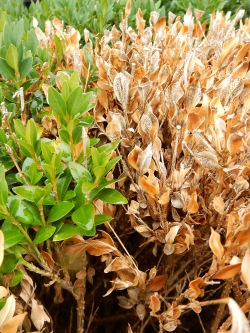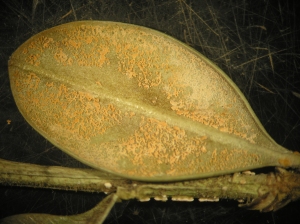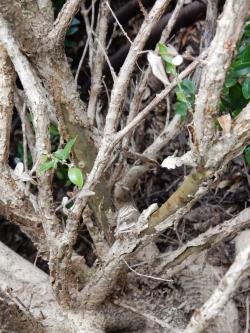Volutella blight is the most common disease of boxwood in the landscape. Volutella blight is caused by an opportunistic fungal pathogen that attacks leaves and stems of damaged or stressed plants. Winter injury, poor vigor, and wounds increase risk for Volutella blight.
Volutella Blight Facts
- Leaves begin to turn red or bronze, eventually becoming straw-yellow (Figure 1). Branches die back from tips and girdling may occur lower on stems (Figure 2). Bark may also be loose on infected branches.
- In moist, humid weather, salmon-to-pink fruiting structures may be visible (Figure 3).
- American and English boxwood are susceptible.
- Disease development is favored by high humidity and temperatures between 65° and 75°F.
- The pathogen survives winter on affected branches and leaves from the previous season.
- Caused by the fungus Pseudonectric buxi (asexual stage – Volutella buxi).

Figure 1: Infected leaves turn from red/bronze to a straw-yellow color. (Photo: Adam Leonberger, UK)

Figure 3: Salmon or pink fruiting structures may be visible in periods of moist, humid weather. (Photo: Paul Bachi, UK)
Management Options
Maintaining a sanitation program and promoting plant vigor are critical for disease management.
- Prune diseased branches.
- Prevent wounding, including improper pruning cuts.
- Maintain plant health with proper nutrition and irrigation practices. Avoid excess water.
- Maintain good air circulation by sufficiently spacing plants or by pruning dense growth.
- Gather and destroy plant debris.
- If disease continues to be a problem after following other management practices, fungicides may be used preventatively beginning in spring. Homeowners may use fungicides that contain mancozeb or copper. Always follow label directions when utilizing fungicides.
Additional Information
- Homeowner’s Guide to Fungicides (PPFS-GEN-07)
- Landscape Sanitation (PPFS-GEN-04)
- Woody Plant Disease Management Guide for Nurseries and Landscapes (ID-88)
- Boxwood Diseases (Penn State Extension)
- Boxwood (Buxus)-Volutella Leaf and Stem Blight {Canker} (Pacific Northwest Plant Disease Management Handbook)
- Volutella Blight – Boxwood (Home & Garden Information Center, University of Maryland Extension)
________________________________________________
By Kim Leonberger, Plant Pathology Extension Associate and Nicole Gauthier, Plant Pathology Extension Specialist

